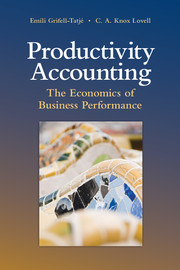Book contents
- Frontmatter
- Dedication
- Contents
- List of Tables
- List of Figures
- Preface
- 1 Introduction
- Part I Productivity and Profitability
- 2 Profitability Change
- 3 Decomposing the Productivity Change and Price Recovery Change Components of Profitability Change
- Part II Productivity and Profit
- Part III Productivity, Cost, and Return on Assets
- Bibliography
- Author Index
- Subject Index
2 - Profitability Change
Its Generation and Distribution
Published online by Cambridge University Press: 05 January 2015
- Frontmatter
- Dedication
- Contents
- List of Tables
- List of Figures
- Preface
- 1 Introduction
- Part I Productivity and Profitability
- 2 Profitability Change
- 3 Decomposing the Productivity Change and Price Recovery Change Components of Profitability Change
- Part II Productivity and Profit
- Part III Productivity, Cost, and Return on Assets
- Bibliography
- Author Index
- Subject Index
Summary
Introduction
This chapter is the first of two dealing with the generation of profitability and the distribution of its financial impacts. Inspired by Davis (1947, 1955), we define profitability as the ratio of revenue to cost, and for the time being we avoid the task of defining cost and revenue precisely. Profitability is not as popular a measure of business financial performance as is profit, the difference between revenue and cost. Regardless of its popularity, however, profitability is surely a useful financial performance measure.
Our primary objective in Chapters 2 and 3 is to identify the factors that generate change in profitability. One set of factors, which we refer to as sources, consists of changes in quantities and prices of outputs and inputs. Individual quantity changes aggregate to the overall impact of quantity change on profitability change, which we call productivity change. Individual price changes aggregate to the overall impact of price change on profitability change, which we call price recovery change. In this framework profitability change consists exclusively of productivity change and price recovery change. A second set of factors, which we refer to as drivers, consists of phenomena such as technical change, change in the efficiency of resource allocation, and size change. The ability of management to harness these factors drives productivity change, which is one component of profitability change. Thus, the term sources refers to quantities and prices of individual outputs and inputs, whose changes influence productivity change or price recovery change, either of which influences profitability change. The term drivers refers to phenomena related to technology and management practices that influence productivity change (but not price recovery change), and hence profitability change.
- Type
- Chapter
- Information
- Productivity AccountingThe Economics of Business Performance, pp. 65 - 111Publisher: Cambridge University PressPrint publication year: 2015



